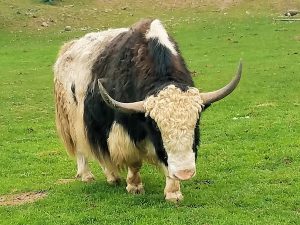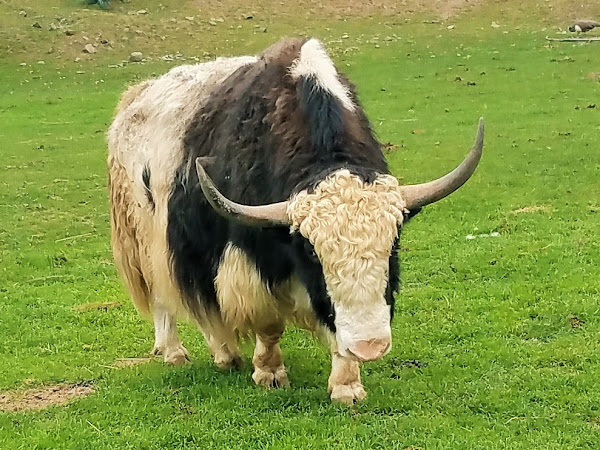Vermont is known for its dairy production, and recently there has been a resurgence in raising sheep and goats throughout the Green Mountains. But one farm, made up of three families, is trying something completely different. The Vermont Yak Company, located in Waitsfield, is the first of its type in the state and possibly New England.
Yaks are native to Tibet and are the perfect cold weather animal, according to Rob Williams, one of the owners of the farm. “Yaks, also known as Bos grunniens, ‘the grunting bovine,’ are the perfect Vermont domesticated animal,” said Williams. “They are cold-weather hearty, incredibly adaptable, and very efficient grazers.” In fact, says Williams, three to four yaks eat the same amount of grass as a single cow. This makes yaks a very economical animal, especially for small farms.
Yaks are typically quiet animals, using snorts, head shakes and grunts to communicate, rather than mooing or whinnying as other farmyard animals do. Domesticated male yaks weigh approximately 1200-1500 pounds and females weigh between 600-700 pounds. It is important that yaks be handled frequently as infants and adolescents to become comfortable around humans before they mature into their full size at around six to eight years of age.
Yaks produce dairy, meat and fiber. Yak dairy products have a high fat content of five to seven percent. This makes it a perfect choice for making butter, cheese and yogurt. Yak meat is deep red with a small amount of fat, generally located around the outside edges of cuts, making it easy to remove. Yak meat is similar in taste to beef, however some say that the flavor is more delicate and the meat itself, more tender. Yak meat contains one-sixth of the fat and 40 percent more protein than beef. Yaks produce two types of fiber, the outer coat called “guard hair” and the inner coat called “down.” While down is similar to cashmere fiber, the guard hair is coarse and rough and usually used for making things like rope, rugs, and accessories like bags and belts. Yaks generally produce one to two pounds of fiber per year. Williams says that the Vermont Yak Company is primarily a meat business currently, however there are plans to experiment with fiber down the road. Bottle fed calves are also raised by request to serve as pack and plough animals when they are matured.
Day to day life on the farm is busy. The herd is currently made up of 31 yaks, including three bulls and a number of calves. The farm is hoping for another dozen and a half calves to be born this spring and summer, and has 15 more animals coming from a ranch out west to supplement the meat supply, according to Williams. “Ultimately, we hope to grow our herd to roughly 100 animals,” said Williams. “Using a few different pieces of land around Mad River Valley.”
The five owners, Rob and Kate Williams and Dave Hartshorn who are in their early forties, and Ted and Susan Laskaris who are in their early fifties, all take turns with farm chores and maintenance, marketing, bookkeeping, and property management. Says Williams, “Our five-person team is blessed with a number of complementary skill sets… And we meet once monthly to resolve any issues, and make decisions together. Our group process has worked reasonably well — and having five kids, ages six through 16 in the mix, makes it that much more interesting!”
Each of the owners holds down a “regular” job as well, with positions ranging from farmer to therapist, businessman to professor, and hockey mom to a non-profit leader. It’s a challenge that the owners feel is well worth the effort.
The idea for the yak farm came to the Williams family on a summer trip in 2007 to Montana. There they sampled yak meat for the first time at a family member’s sheep ranch. Upon their return to Vermont, the Williams family had continuous conversations with two neighboring families, the Laskaris and Hartshorns about how they might best utilize some of the unused agricultural land in the Mad River Valley. “All of us in the business were looking to bring a beautiful piece of arable farm land back to life, to get our hands dirty, and to develop what we hope is a new model of multi-family community farming that may have some staying power in this new century,” said Williams. “We did most of our research by talking with other yak owners, mostly out west, and talking with farm-focused friends and neighbors. And our abiding interest in the ‘localvore’ movement, in providing healthy, tasty, nutritious local grass-fed meat to our community, and in introducing a new and wonderful species of animal to Vermont all played a role. As we like to say: ‘Three families, two farms, one vision = Vermont Yak Company.’”
Marketing for any new business can be a challenge. According to Williams some of the farm’s best marketing so far has been word of mouth. Saturday farmers’ markets and local restaurants including Hen of the Wood, the Round Barn, American Flatbread, and Timbers at Sugarbush, have all been great places for people to see for themselves how delicious yak meat really is, says Williams. Meat is also sold directly from freezers on the farm on request and there are plans to sell to local grocery stores this summer or early fall. Vermont Yak Company also sells yak-related merchandise on its website including T-shirts, bumper stickers and yak hides. With the recent interest in eating locally (called “localvore or locavore eating”) Vermont Yak Company’s offering of a meat product unique to Vermont may be a big boon to the business.
Williams says that the hope is for the farm to be fully sustainable by 2010. The owners are encouraged with the positive response that they’ve had so far to Vermont Yak Company. “We encourage folks to make an appointment to come by the farm and meet Vermont’s newest four-hoofed inhabitants,” says Williams.
This article was contributed by By Joy Perrino Choquette.
 Related Articles & Free Subscription
Related Articles & Free Subscription
Skiing in Vermont: Big Ideas and Quirky Characters
The Vermont Republic – The Story of When Vermont was an Independent Country




Comment here